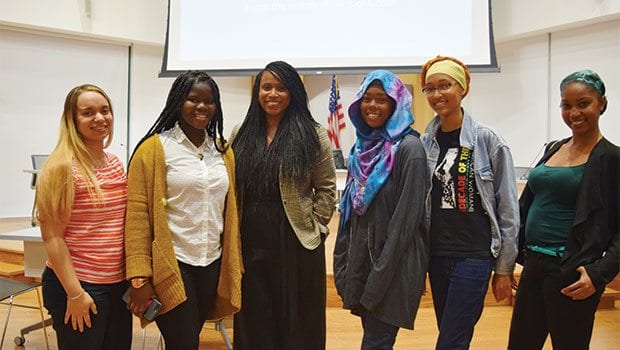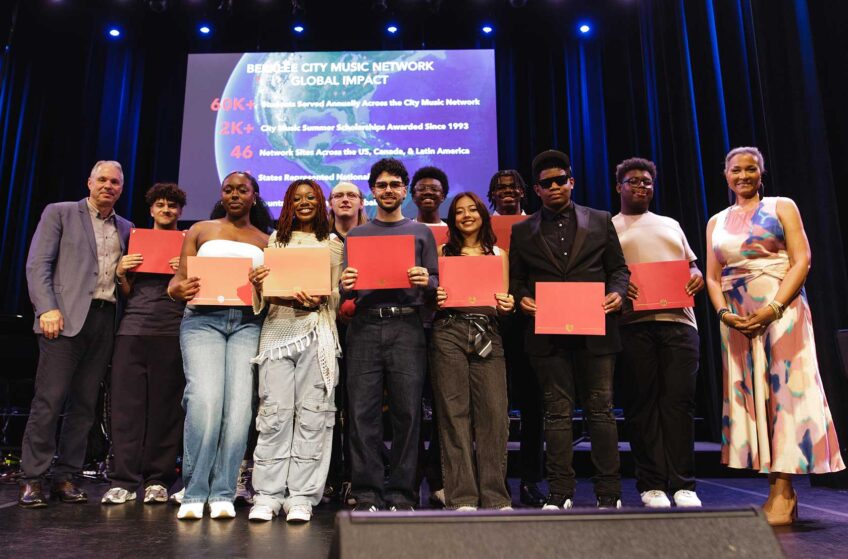
At-large Boston City Councilor Ayanna Pressley held the first-ever listening-only forum on September 11 for girls of color and their parents on how school policies have affected their well-being and academic experiences.

Author: Karen MoralesCity Councilor Ayanna Pressley interviews students.
This past summer, Pressley helped the National Black Women’s Justice Institute conduct focus groups with more than 100 girls of color from Boston Public Schools about their experiences with school climate and discipline policies. The testimonies from these focus groups were also shared at the hearing.
“The school-to-prison pipeline is growing for girls. Research shows that girls of color are disproportionately impacted by school discipline policies, which can too often result in long term negative life outcomes,” said Pressley.
“I want to ensure that here in Boston, our policies and programs are co-constructed with our girls, and have the intended outcomes that lead to safe and productive school environments for all students,” she said.
Pressley and NBWJI plans to use the testimonies, data research and the focus group results to craft policy recommendations to improve the academic experiences of girls of color in Boston Public Schools.
Out of the 45 attendees, 12 students, four parents and two researchers testified.
Chavelyn Santana, a former student at John D. O’Bryant who is currently studying at Lasell College, shared her personal experience dealing with test-taking anxiety and low expectations from educators towards students.
As someone who excelled at homework, projects and in-class assignments but struggled with taking exams, Santana was disheartened that the school did not support her learning style, especially since most of her grade was based on exam scores.
“Then you have other factors weighing in on that: you’re a person of color, you’re a female, you have an accent,” she said. “You start believing, maybe I am just a C-average student. Not the one that’s going to succeed. That really does take a toll on you.”
She also recalled a time when she spoke to a teacher about applying to colleges. “She told me to apply to community college as if that’s the only thing I could aim for. And that takes out more motivation from you. If this professor doesn’t believe in you, why should you believe in yourself?” said Santana.
Unequal discipline
Paula Kelly, a mother of two Boston Public School students and a representative from the Collaborative Parent Leadership Action Network, testified to hairstyle policies that targeted her biracial daughter.
“It’s well known that many educational institutions have unfair hair policies intolerant of beads they call noisy, natural afros they claim are too big, dreads, extensions and hair coverings for both Muslim and non-Muslim girls,” she said. “Those policies are just plain racist in my opinion.”
She suggested a possible solution. “I would like to see more educators and administrators provided with more bias training, as well as learning about and respecting other cultures,” she said.
In addition, Kelly said that the BPS curriculum is too Eurocentric and that educators should teach students more about leaders of color in history.
Several young women, current students at Boston Public Schools, charter schools and private schools, stepped up to the microphone and shared their personal experiences.
Many of them expressed frustration for constantly receiving disciplinary action for dress code violations that were deemed too distracting. Consequently, they lost class time because of this.
The girls often felt objectified and sexualized by their schools, whether their clothes were revealing or not, especially for girls who appear more developed than others.
Aishatu Yusuf, a senior research policy fellow for NBWJI, presented testimonies from the focus groups conducted with girls of color from Boston Public Schools over the summer. “The reason we do qualitative research, the reason we speak to young people and adults from impacted communities, is because their voices are too often left out,” she said.
“We want to tell their stories and put them at the center of the conversation,” said Yusuf. “We put a face to statistics, feelings with percentages.”
She presented a quote from a black Dominican girl attending high school in Boston:
“My school actually did something. After it all happened, they gathered a bunch of us black kids, we sat down, all the administration, all the faculty, the janitors…we sat in the auditorium, and we led the conversation. They asked us how we felt, what we needed and what we expected from them. They told us what they needed and expected from us. And they listened. They actually listened. You could just tell there was a shift and change in our classrooms. Students leading the conversation was so beneficial because oftentimes teachers just don’t understand. “
Another young woman said, “I got into a fight with a white girl. She got suspended for two weeks and I got expelled. But we were both fighting.”
When asked about dress code policy, “They all said dress code for what they get in trouble for. They said they understand the school wants them to look presentable, but the definition of presentable changed depending on who they were and what they looked like,” said Yusuf.
Another girl said, “I’m black. So my natural hair is big and curly. I wore it out once and was told to go to the principal’s office to tie it down because it was distracting other students. That was the last time I did that. I was really embarrassed, I wanted to shave my head, but my mom wouldn’t let me.”
In response to law enforcement officers being placed in schools, young women from the focus groups said they felt safer with more guidance counselors in schools, rather than cops.
Misha Inniss-Thompson, a doctoral student at Vanderbilt University who works with NBWJI, presented numerical research that complemented the narratives shared by Aishatu.
“Neither quantitative or qualitative data can stand alone,” said Inniss-Thompson. “We need both to create effective policies.”
The data analysis is based on comparing discipline outcomes between girls of color (black and Latina) and white girls. The analysis used nationwide data collected from the 2013 – 2014 academic year, which is the most recent and most comprehensive report made available via the US Department of Education Office for Civil Rights.
According to the report, the nationwide racial and ethnic breakdown of 50,035,744 female students in K – 12 public and charter schools was 50.3 percent white, 24.7 percent Hispanic and Latina, and 15.6 percent black.
Black girls were seven times more likely than white girls to receive one or more out of school suspensions, four times more likely to be arrested in school, and over two and half times more likely to be referred to law enforcement. Latina girls were found to be one and half times more likely to receive an out of school suspension, get arrested at school, and referred to law enforcement.
To view the entire report, visit NBWJI.org, and click on the “resources” tab.
“I’m struck by the common thread among the testimonies of feeling unsafe and unheard,” said Pressley. “As Dr. Monique Morris [co-founder of NBWJI] once said, ‘Our girls are sacred and loved.’”
She continued, “Based on what you shared, it’s very clear, most of our girls do not feel sacred and loved. and we have to fix it.”
In October, Pressley will hold a second hearing for school personnel to discuss school climate, discipline policies, and disparities in suspension rates, and trauma-informed practices.






